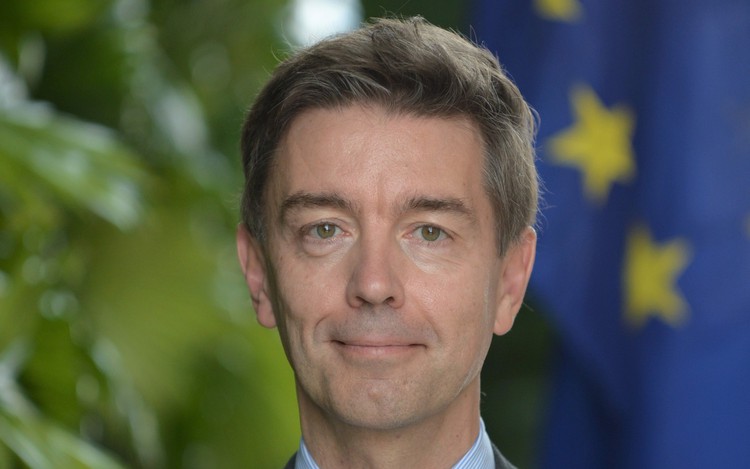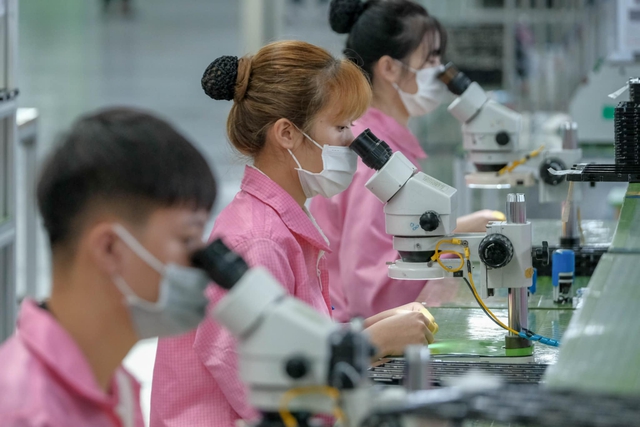
EU Ambassador to Vietnam Julien Guerrier. Photo: EU Delegation to Vietnam
Since its implementation in August 2020, the EVFTA has eliminated 99 percent of tariffs and facilitated over €64 billion in goods trade and €10.7 billion in EU investment.
Guerrier spotlighted Vietnam's enhanced competitiveness, attracting not only EU investment but also interest from global firms eager to use the Southeast Asian country as a gateway to the EU market.
Despite its success, challenges remain.
Vietnamese businesses continue to struggle with rules of origin and stringent EU standards.
Guerrier noted that while Vietnam has useful tools like the FTA Index and benefits from EU training programs, modernizing customs procedures remains essential.
He also insisted on maintaining regulatory consistency and avoiding new barriers that could erode the agreement's benefits.
Encouraging signs have emerged, such as faster pharmaceutical approvals and sustained government engagement with EU investors.
However, Guerrier urged further reforms to unlock high-quality investment, especially in areas like agri-foods and high-tech.
Looking ahead, the EU sees Vietnam as a key partner in strengthening global supply chain resilience and pursuing cooperation in strategic sectors such as semiconductors, critical raw materials, and green energy.
Guerrier underscored that the EVFTA is just the beginning – a platform for deeper cooperation to support Vietnam's transition to a digital, green, and innovation-driven economy.
With ongoing efforts to improve the business climate and reinforce multilateral trade rules, the EU remains committed to being a reliable and high-quality partner in Vietnam's long-term growth.
After five years of implementing the EVFTA, could you highlight some key developments in trade relations between the EU and Vietnam, along with the achievements resulting from the EVFTA's implementation? Are you satisfied with what has been accomplished so far?
The EU-Vietnam FTA, or EVFTA, was the first FTA of the European Union with a leading economy in South and Southeast Asia (excluding Singapore). It is also one of the EU's most ambitious trade agreements with an emerging economy, eliminating 99 percent of tariffs. Beyond tariff reductions, it provides a strong legal and economic framework that supports growth, encourages investments, and promotes mutual benefits for both sides.
The EVFTA has stood the test of time and proven its resilience, having withstood major global challenges like the COVID-19 pandemic, Russia's war in Ukraine, and current geopolitical uncertainties. It stands as a clear symbol of the EU's commitment to strong, resilient, and rules-based trade with a key ASEAN partner.
The trade and investment figures show that relevance and success: since the EVFTA entered into force on August 1, 2020, trade in goods reached over €64 billion in 2024. Trade in services has been growing to €8.4 billion. And EU investment grew to €10.7 billion.
In your opinion, what competitive advantages does Vietnam hold over other partners under the EVFTA? Many believe that the benefits have primarily come from exports and trade. Do you agree with this assessment?
Certainly, thanks to the EVFTA Vietnam improved its competitiveness as compared to neighboring countries which are now trying to catch up on the benefits they see of the agreement with the EU. On top of the tariff elimination, the EVFTA also offers an incentive to FDI (EU and non-EU) as Vietnam becomes an attractive place to invest in and a destination from which investors can access the EU market, all contributing to the development of the country.
Over many years, Vietnam's economic performance has been standing out. Vietnam's capacity to attract investment and talent, and its ability to produce and trade certainly have been important ingredients for the nation's success. And Vietnam has benefitted from a population dividend, with many young people joining the job market and bringing the right qualities.
Between the EU and Vietnam, the EVFTA has been a solid legal and economic framework to foster growth, investment, and mutual benefit. Making the most of the EVFTA is the obvious starting point. This means that implementation matters: reducing unnecessary regulatory barriers is crucial. We should also avoid introducing new barriers that go against the spirit of the FTA, as they risk undermining the benefits of tariff elimination.
EU businesses need a transparent, predictable, and welcoming environment to invest in and grow even more. I have seen Vietnam' creativity and capacity to solve problems quickly and efficiently. In times like these, a balanced and reciprocal partnership is beneficial to both sides and it will lay the foundation for our future.
Despite the opportunities brought in by the EVFTA, many Vietnamese businesses still struggle with rules of goods origin and the EU's stringent technical standards. How do you see this issue in practice? Are there any plans from the EU to provide support or introduce more flexible mechanisms to help Vietnamese companies better take advantage of the agreement?
Vietnam has 17 FTAs. As global trade becomes more complex, it is important to manage customs procedures well. This includes things like how products are classified, valued, and where they come from. The European business community in Vietnam has pointed out that improving customs procedures would make it easier for companies to do business.
In fact, many countries around the world are working to modernize their customs systems. Vietnam already has a useful online database, the FTA Index, to help with implementing trade agreements. The EU is also working to make its own customs rules simpler and cheaper for both businesses and governments. Recently, we supported training for Vietnam's customs officials on rules of origin. And thanks to the EVFTA, we can do even more together in this area.
Just like in the EU, rules and regulations in Vietnam also change over time. The EU tries to share early information about new rules and helps raise awareness and prepare businesses, especially small- and medium-sized ones, as well as the Vietnamese authorities. The EVFTA is a great tool for both sides to exchange information and stay up to date on these changes. It helps make sure that businesses on both sides can adapt more easily and continue to trade smoothly.

Employees work at an FDI enterprise's factory in Bac Ninh Province, northern Vietnam. Photo: Ha Quan
Several surveys indicate that the business confidence index of EuroCham in Vietnam is quite positive, with expectations that the EVFTA will serve not only to boost exports but also to open up the Vietnamese market to European businesses. From your perspective, have European investors been able to fully seize this opportunity?
We understand businesses need clarity and predictability before they make any decisions about long-term investments. And because businesses have every interest in the success of Vietnam, every year EuroCham Vietnam offers its best knowledge of what change will make a really big difference for business and at the same time help Vietnam achieve its growth, its development, its technological ambitions.
We see the potential for more, in many areas. Much depends on where we see Vietnam standing in 5-10 years. This 5th anniversary of the EVFTA therefore is not only a moment for looking back, but even more the moment for looking forward at the future opportunities that are there for Vietnam and for EU businesses in the country.
Vietnam's prime minister has held multiple dialogues with foreign investors, including European businesses. Efforts to reform administrative procedures and remove regulatory barriers to accommodate EU enterprises have also been clearly demonstrated. How do you assess these efforts? What more should be done to attract high-quality investment from the EU and major global firms?
The dialogue of the prime minister with EU businesses certainly offers a precious moment to suggest ideas that can lead to real improvements. I had the opportunity to attend one of these meetings earlier this year, and it was very encouraging to see Vietnam's leadership open to listening and engaging.
While it might still be too early to see big changes in some areas, for example, agri-food imports still face a lot of red tape that makes trade difficult, we are starting to see progress in others. In the pharmaceutical sector, for instance, the approval process for new medicines is becoming faster. This is good news for Vietnamese patients and also for European companies that can bring new treatments to Vietnam. We hope to see similar improvements in other sectors as well.
In the context of major economies increasingly adopting trade protectionism and imposing tariffs, while Vietnam is also accelerating market diversification, how do you assess the role of the EVFTA in helping the EU and Vietnam maintain a sustainable and stable supply chain?
The EU and Vietnam are trusted, reliable partners in an increasingly uncertain global trade landscape. In this uncertain world, other countries in South and Southeast Asia choose to follow the example of the EVFTA. The EU currently is negotiating trade agreements with India, Indonesia, Malaysia, Thailand, and The Philippines.
The EU and Vietnam stand for open and rules-based trade. The EVFTA and everything we can do to make the EVFTA deliver fully and effectively add credibility to our commitments. With the EVFTA, we are keeping openness, stability, and predictability high. We offer options and space to our companies.
For rules-based trade, the EU will also continue its efforts in reforming the World Trade Organization (WTO) to ensure that it provides an effective and stable framework to address the challenges of today and the future. And the EU is working with others like with Vietnam or the Comprehensive and Progressive Agreement for Trans-Pacific Partnership (CPTPP) to explore how to strengthen multilateral rules, how to facilitate trade among us, and how to approach emerging challenges such as ensuring the resilience of our supply chains.
We welcome every effort by Vietnam in the same direction, like its recent announcement of working toward joining the Multi-Party Interim Appeal Arbitration Arrangement for resolving WTO disputes, or the recent CPTPP announcement of working toward dialogue with the EU.
The EVFTA offers a platform for the EU and Vietnam to exchange and cooperate on these topics and on what else both sides can do to strengthen economic resilience and diversify supply chains.
Looking ahead, which areas of cooperation will the EU prioritize with Vietnam in the next phase of EVFTA implementation? What steps will you and the EU take to further strengthen the effectiveness of the agreement?
The EVFTA is not the final step – it is the foundation. The EU and Vietnam should jointly explore deeper cooperation in strategic sectors, including semiconductors, critical raw materials and renewable energy, with a shared objective of strengthening economic resilience and diversification.
Vietnam is carrying out deep administrative reforms and it has high economic, development, and reform ambitions. All three should make Vietnam more efficient, mobilize new sources of growth, increase productivity, and attract more European investors. The aim is to create opportunities in new sectors and bring in modern technologies. At the same time, local investment can also play a big role in driving growth and innovation.
The EU is a trusted, safe, and high-quality partner to support Vietnam's in all these changes, for the green transition, for infrastructure and energy development, a digital economy, and ambitions in high-tech sectors. EU companies stand ready to contribute as secure, reliable, and trusted partners to Vietnam's strategic projects.
Thank you for your time!


Max: 1500 characters
There are no comments yet. Be the first to comment.